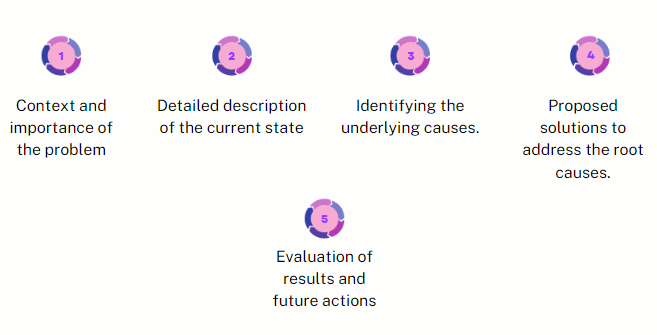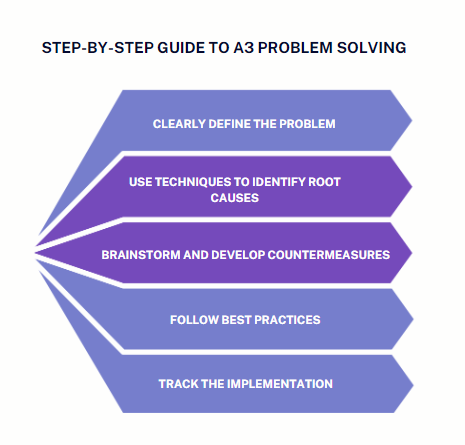Have you ever found yourself in a situation where you were faced with a problem and didn’t know where to start? While this can be a daunting scenario, there are a number of frameworks you can leverage to take some of the guesswork away and set up a process for approaching these in the future. One of these is the A3 problem-solving framework developed from Toyota’s lean manufacturing practices.

The A3 problem-solving framework uses a structured approach to address complex problems and gets its name from the A3-size paper used to document the process. With it, you can diagnose the root cause of complex problems and resolve them efficiently.
This article explains the A3 framework, how to use it for problem solving, and accompanying best practices.
Understanding the A3 framework
The A3 problem-solving framework is a structured approach that uses a single A3-sized sheet of paper to document the entire problem-solving process. It includes several key components:

- Background — Context and importance of the problem
- Current conditions — Detailed description of the current state
- Goal statement — Clear objectives to achieve
- Root cause analysis — Identifying the underlying causes
- Countermeasures — Proposed solutions to address the root causes
- Implementation — Steps to put the solutions into action
- Follow-up — Evaluation of results and future actions
The A3 framework offers several benefits. Think of it as a structured approach to problem-solving. Using it will promote clear documentation, and improved communication among team members.
Step-by-step guide to A3 problem solving
There are a few key steps to correctly apply the A3 problem-solving framework. Each structured step guides you through the entire process. It helps you develop the skill of identifying gaps and proactively resolving issues.
Each step also builds up the understanding of the problems:

Here are the key steps involved:
- Step one — Clearly define the problem and understand its background and current conditions
- Step two — Use techniques like the 5 whys and fishbone diagrams to identify the root causes
- Step three — Brainstorm and develop effective countermeasures to address the root cause
- Step four — Follow best practices to implement the chosen countermeasures and ensure stakeholder buy-in
- Step five — Track the implementation, evaluate results, and ensure continuous improvement
This method resolves the immediate issue effectively. Additionally, it lays the groundwork for ongoing improvements and sustainable long-term success.
A3 framework case study
Spotify used the A3 framework effectively to rectify an issue it had with its weekly feature engagement. Its product management team applied the process to identify and resolve the root cause. In this case, the A3 framework looked like:
- Define the problem — The team noted a significant drop in user engagement with Discover Weekly playlists
- Analyze the root cause — Using the 5 whys technique, they discovered that the algorithm wasn’t personalizing recommendations effectively, leading to irrelevant song suggestions
- Develop countermeasures — The team brainstormed solutions. From refining the algorithm to better account preferences, they considered precise countermeasures
- Implement the solution — They rolled out the improved algorithm in stages. Close monitoring of user feedback and engagement metrics proved game-changing
- Evaluate — Here, the team continuously tracked engagement metrics and user feedback after the update, which led to several iterative adjustments to the algorithm over time
Best practices for using the A3 framework
As a product manager, you should adopt specific best practices to maximize the A3 framework’s effectiveness. These practices focus on documentation, collaboration, and continuous improvement:
- Maintain clear and concise documentation throughout the A3 process. You need to promote a culture of transparency and progress tracking
- Encourage cross-functional collaboration. Involve the right stakeholders to gather valuable data. A good collaboration is based on diverse perspectives and expertise
- Emphasize the need for continuous improvement. Also, regularly revisit the A3 document to update and refine it
By following these best practices, you can leverage the full potential of the A3 framework.
Key takeaways
When it comes to complex issues, implementing the A3 problem-solving framework allows you to solve them systematically and effectively. This structured approach ensures that root causes are identified and solutions are developed and implemented in a timely manner.
The following key pointers will prove useful for your day-to-day reference:
- Clearly define problems and understand the background and current conditions
- Use root cause analysis techniques like the 5 whys and fishbone diagrams to identify underlying issues
- Develop targeted countermeasures and implement solutions with stakeholder buy-in
- Maintain clear and concise documentation throughout the A3 process
- Foster cross-functional collaboration to gather diverse insights and expertise
- Emphasize continuous improvement by regularly revisiting and refining the A3 document
By integrating these practices into your problem-solving strategy, you can tackle challenges head-on. Good luck! And as always, comment with questions.
Featured image source: IconScout